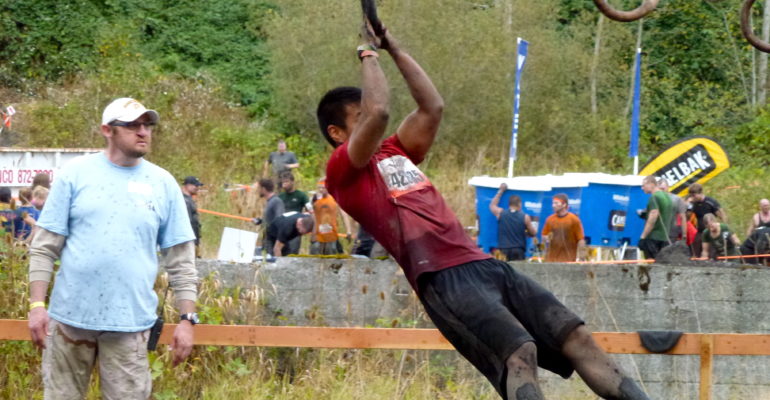By Kevin Hirose – BKin, CSCS
Many of you have heard of Tough Mudder, know someone who has done it or have even done it yourself. Perhaps you are currently signed up for this event or are thinking of signing up and haven’t starting training for it (more on that later on). The first Tough Mudder event was held on May 2, 2010 at Bear Creek Ski Resort near Allentown, PA (USA) and its popularity has skyrocketed from 3 events in 2010 to over 50 worldwide becoming a global phenomenon.
Some details about this thriving event going on at least 4 continents at the moment:
10-12 mile outdoor obstacle course
very popular in North America, Australia, Europe and growing in Asia
can be done as a team or individual
NOT considered a race but a “challenge”
over 14,000 participated in Tough Mudder Whistler on June 23rd, 2012
obstacles may include 20-foot drop into water, electroshock tentacles, tons of mud, and even burning vehicles
Tough Mudder Seattle September 2012 – My friend and APEX co-founder Victor hanging out on the rings for about 5 minutes straight! He was actually included in the official Tough Mudder 2013 Teaser Video @ the 25 second mark! Watch it here!
Having done Tough Mudder three times, I am very familiar with its challenges and overall content and flow. There are about 20-25 obstacles spread out over 16-20 km so there is plenty of running and/or walking involved so you must train to run on various terrain such as dirt, gravel, and even snow. However, it is unlikely you will have to run more than 3 km per stretch since the trail is separated by the obstacles. At this point you may be intimidated or intrigued or pumped or perhaps a combination of all the above. Well, if you are interested in participating and do not want to get destroyed or want to improve on your previous time or want to reduce the chance of injury here are a few training tips from a guy who has already done it THREE times:
- only jogging long distances is usually not enough
- incorporate interval training into your running/energy systems training
- include strength training (lower body, upper body, core)
- get accustomed to various terrain, crawling, climbing, jumping and swimming
A Sample Weekly Program:
Monday – Strength Training, Interval Training (15-25 min – running, bike, elliptical)
Tuesday – 5-10k trail run
Wednesday – Strength Training, Optional: *Tempo Training (20-30 min – treadmill, bike, elliptical)
Thursday – Active REST (walk, yoga, mobility work)
Friday – Long, slow distance run (45-60 min – work your way up progressively to this duration, if de-conditioned)
Saturday – **Circuit Training / Conditioning Circuit
Sunday – Complete REST or Active REST (walk, yoga, mobility work)
* Tempo Training is cardiovascular training or, more accurately, energy systems training focused on increasing anaerobic threshold or lactate threshold of an individual. Basically, it functions to enable one to perform at a higher intensity or speed before fatigue from the glycolytic (lactate) system decreases performance.
**SAMPLE Conditioning Routine
Goblet Squat 30s
Burpee 30s
REST only when needed
Do 3-5x (depending on fitness level)
REST 2-3 min
Two-handed or One-handed KB Swing 20 reps
Bear Crawl 20 metres
REST 30s
Do 3-5x (depending on fitness level)
COOL-DOWN + STRETCH
Important Notes:
If you are obese or have health issues please consult your physician before starting exercise
If you are completely out of shape or de-conditioned slowly and gradually, over several weeks, increase frequency and intensity of exercise/training
Purchase proper trail running shoes or standard running shoes for running training and wear WELL-CUSHIONED runners THAT ARE WORN-IN for the event (AVOID minimalist shoes since the terrain could cause much foot discomfort)

Have a good pair of trail running shoes is recommended
Suggested Training Timeline by Fitness Level
De-conditioned: 4-6+ months
Average: 2-4 months
Fit: 1-2 months
So whether you are ready for the challenge or just want to train like a “Tough Mudder” give the sample outline a try and if you really want to take it to the next level hire a trainer or coach to assist you in creating a program specific to your needs and current fitness level.

